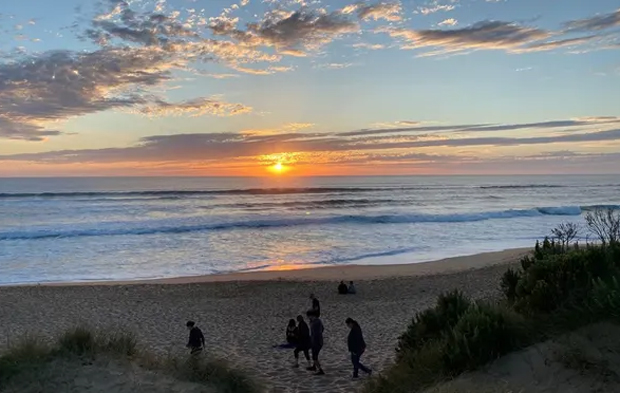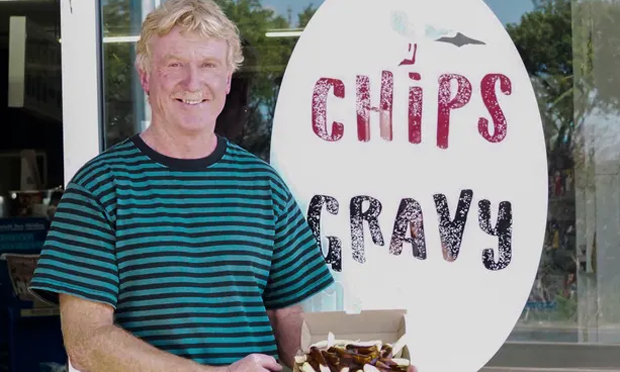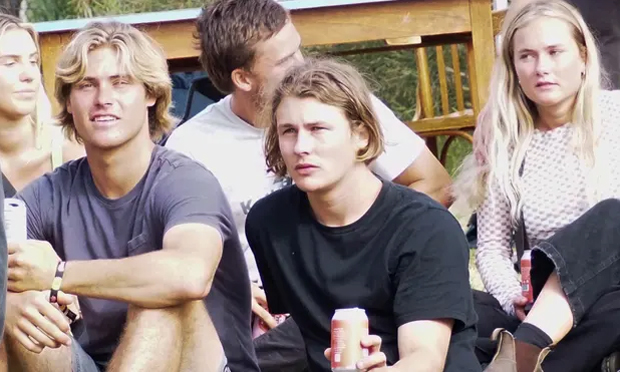
Rye beach. Tradies who moved here in the 90s for the surfing lifestyle are now sitting on properties worth a million-plus, and most aren’t budging . Photograph: Frank Magree

Mark Watkins at the Dundas Street Milk Bar. Photograph: Frank Magree

The next gen at the Ninch Fest music festival. Photograph: Frank Magree
26 April 22
Gentrification hasn’t reached this part of the Mornington Peninsula, where residents say ‘if you don’t play golf, surf or fish, you’re going to struggle’
From The Guardian: It’s a few hours from the Goldfields, where I live, to Rye, where my boyfriend Frank lives, but also a few decades. For a Brit like me, this coastal Victorian town is like wandering into the pages of Puberty Blues – and exactly how I imagined Australia to be, back before I actually moved here.
Most of the Mornington Peninsula (or Ninch, to locals) might be undergoing one long facelift, but Rye – in particular the back beach area – is an enclave that has held fast to its wild and woolly roots. Tradies who moved here in the 1990s for the surfing lifestyle are now sitting on properties worth a million-plus, but most aren’t budging – and neither are their kids.
Serving the area is one short retail strip, including a milk bar, a bottle shop and a surfboard shop. Dundas Street Milk Bar is an institution for its hot chips and gravy, but also for its resident one-legged seagull, Lefty. Inside, you can buy fishing bait (mainly for the benefit of co-owner Mark Watkins), Point Break merch and surf wax. They do sell Big M flavoured milk, but they’ve also gone progressive with Soy Boy. On a whiteboard there are printouts of the top surf months, the data Watkins has been collating for 20 years, and which causes many arguments among customers.
“We all have an idea of when the surf’s good, and I would have said February, but it’s nowhere near the best,” Watkins says.
The formidable surf breaks have names like Gumboots, Snatches, Head Injuries and Spooks. Watkins says few are secret these days, but some are too fickle for non-locals to master. And even he’s warned off if he strays from his usual territory.
“There are a couple I go to, west of my spot, and in a jokey way I’ll get: ‘What are you doing here? Got your visa?’” he says. “If you’re a stranger, good luck.”
There is some intense localism around here – diehards sport “3941” postcode tattoos, others “Rye or Die”. You might also spot the odd “Fuck off, touros” sign at beach tracks, but then localism isn’t confined to Rye. Frank points out he had a similar greeting written in surfboard wax on his car window once in Portland. There are seemingly so few coastal towns that haven’t had their barefoot culture diluted by gentrification, that those living in these pockets can get protective.
“It’s not that easy to get to know people here,” Watkins admits. “I’ve seen people move in and then move back to Melbourne because, basically, if you don’t play golf, surf or fish, you’re going to struggle.”
Watkins estimates seven out of 10 houses on his road are holiday homes, but he finds the new builds inoffensive. They’re not volume-builder constructions and they tend to be set back, concealed by the tea trees. Plus, the local tradies get to work on them. While a recent Guardian articledetailed the huge rent hikes in the Mornington Peninsula, people I talk to here say their kids often move back in, or pile into open-door share houses, or build on one end of their parents’ block.
For me, growing up in a boring satellite town of London, the goal was to leave home fast and never return. It was the same for Frank, growing up in Vermont in Melbourne’s eastern suburbs. But here, kids tend to boomerang back.
Frank’s 20-year-old daughter, Stella, went to WA for two years and has noticed some subtle differences upon her return.
“Every car on the road used to be a beaten-up tradie car,” she says. “Now you park at carry and there are $100,000 cars everywhere and wedding photo shoots.”
I should explain “carry”. It’s a car park behind Rye Ocean Beach where locals often back up and cook snags. As 19-year-old pro skateboarder Zepp Heyes tells me, “It’s almost like if our generation didn’t have phones. No one says, ‘We’re going to carry’ – everyone just rocks up. If someone’s not at the carpark they’ll be at the Dundas Street Milk Bar.”
Zepp moved to Noosa a few months ago, but he’s already returned to Rye twice; once for his dad Drew’s legendary Ninch Fest, a music festival in its sixth year that has a distinctly uncorporate vibe. “It’s a reunion party, the sickest time,” Zepp says. “My girlfriend had never experienced anything like it and she absolutely frothed it.”
During lockdowns, the then-Mornington Peninsula Shire mayor Despi O’Connor petitioned for the region to be annexed from metropolitan Melbourne, but the pandemic barely affected socialising in Rye. With only one bar that’s deemed worth frequenting, and the city too far to bother, socialising instead centres around house-hopping and beach doofs. And it tends to be intergenerational.
“It’s like we’re all the same age,” Zepp tells me. “Dad sends us a different song he’s discovered each week. We’ll be like, ‘That’s sick!’ and send him one back.”
His dad adds, “We tend to put a lot of effort into our music and surfing and partying, because that’s the lifestyle we chose over career.”
Heyes Sr, a glazier, bought his block in 1998. The house is an ever-morphing construction of recycled windows, pier timber and mosaic panels, with a water treatment plant and solar power system.
“A lot of people are like-minded in that way,” he says. “We will always go to protests about the blowing up of the heads and so forth. You’re really conscious of your local environment, and the greater environment as well.”
For some, though, Rye has become too mainstream. Amy Hackett first hitched here to surf in 1980, aged 15, when the demographic was largely Italian, but has moved to Phillip Island. Back then, she befriended the legendary surfers and surfboard shapers of the area – many immortalised on podcast Salt of the Peninsula – and joined the Peninsula Board Riders at a time when women’s surfing competitions were an afterthought.
“There weren’t a lot of women surfing because it wasn’t accessible like now. It was raw,” she says. “In the water I became renowned for a drop-in because if I didn’t stake my place I’d be out the door.”
Every girl has a surfboard these days, and she’s noticed the 80s and 90s fashions resurfacing. “It’s funny to see them embrace it like they’ve invented it; I crack up laughing,” she says.
But the kids are all right. As Frank points out, with such a small friendship and dating pool, etiquette is vital.
“Everyone parties hard down here, but inside that looseness there is an order,” he says. “The minute someone crosses a line here they get pulled up by young and old.”
His 22-year-old son Luca lives at home at the moment, but has done stints working at the snow and in Byron Bay, and is soon off to Spain (all with mates from the Ninch), which Frank thinks is a good thing: “At least for a bit,” he says, “because it is a bit [of an] insular peninsula, and there’s a big wide world out there.”
- AUTHOR: JENNY VALENTISH
- SOURCE: THE GUARDIAN
Please choose your region
Australia | US / Rest of the World(Changing your region, will clear your cart)